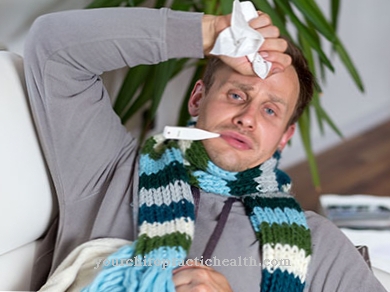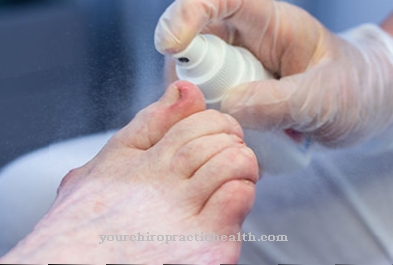A Claw hand occurs as a result of ulnar paralysis. Depending on the underlying cause of the disease, other symptoms can occur. The treatment of the claw hand is possible and promising in many cases.
What is a clawed hand?

© BigBlueStudio - stock.adobe.com
A claw hand is a disorder of the hand that manifests itself in functional failures in the bones. The hand can no longer be moved normally and those affected have a splayed thumb that cannot be bent.
The metacarpophalangeal joint is also damaged and leads to the typical alignment of the fingers, which is like a claw. In connection with a clawed or clawed hand, numbness in the little finger and the ball of the little finger often occurs. The unnatural position of the hand leads to further complaints and massive restrictions in everyday life.
causes
The claw hand is the cause of ulnar paralysis. This can have various causes. Often it is due to external violence in the area of the upper arm. Fractures, injuries or surgical interventions can also trigger ulnar paralysis and thus the claw hand.
In addition, a clawed hand develops when the ulnar nerve is exposed to long-term pressure. This is the case, for example, when the elbow is used as a support. This can lead to paralysis in the long term and later the development of a clawed hand.
People who regularly practice cycling are also at risk because the ulnar nerve is also heavily stressed here. The same applies to bedridden people who put excessive strain on the nerves and patients who are not adequately padded during an operation on the relevant part of the body.
Generally, the causes can be traced back to damage to the ulnar nerve. It is also known as ulnar channel syndrome. Tumors or cysts that lodge in the ulnar nerve can also be the cause.
Symptoms, ailments & signs
A clawed hand can primarily be recognized by the misalignment of the fingers that gives it its name. Affected people notice that the metatarsophalangeal joints of the fingers are hyperextended and the terminal joints are slightly bent. The claw hand on the ring finger and the little finger can be seen particularly clearly. Usually it is no longer possible to spread or pinch your fingers together.
The misalignment causes other symptoms such as pain, numbness and cramps in the hand. Sensitivity disorders can also occur. If the abnormality occurs in connection with an injury to the hand, swelling, bleeding and other external signs may be added to the symptoms and discomfort mentioned.
A clawed hand often only becomes noticeable after months or even years, as the symptoms develop insidiously. In most cases, permanent damage has already developed, for example nerve disorders or joint wear due to the persistent misalignment of the fingers.
Furthermore, circulatory disorders can occur and scars remain. If the claw hand is treated early, long-term consequences are unlikely. The postural anomaly disappears quickly after an operation or drug treatment and only slight pain and feelings of tension remain, which also decrease after a few weeks.
Diagnosis & course
The suspicion of a clawed hand can usually be expressed by the person concerned. The misalignment of the hand clearly shows that there is damage. Numbness in the fingers is also a first indication. The doctor can confirm the suspicion in a comprehensive discussion with the person concerned. For this purpose, the medical history is checked and the doctor is asked about everyday professional life.
After taking the medical history, a neurological exam is done. Various function tests are used to test the ulnar function and to check whether ulnar paralysis is present. One of the tests concerns the flexion of the hand and fingers. This is followed by what is known as electromyography. This measures the nerve conduction velocity, which in turn provides information about paralysis.
Once the claw hand has been clearly diagnosed, the exact cause must still be found out. Ulnar paralysis is often the trigger, but other nerve diseases can also be responsible for the symptoms.
A clawed hand develops slowly and is usually recognized too late by those affected. However, if action is taken early on, the paralysis can regress. If the disease has progressed too far, all that remains is to alleviate the symptoms. The clawed hand is not fatal, but it does result in far-reaching restrictions in everyday life for those affected.
Complications
With the claw hand, there are severe restrictions in the movement and function of the hand. Those affected can no longer move their fingers properly and are often dependent on the help of other people in everyday life. Especially in children, the claw hand can lead to considerable difficulties and significantly reduce the quality of life.
This can also disrupt and delay the child's development. Furthermore, those affected suffer from severe misalignment of the fingers, which leads to pain. The hand is not infrequently swollen. The hand and fingers suffer from numbness or are completely paralyzed. The typical tingling sensation and other unpleasant sensory disorders occur. In the worst case, the paralysis is irreversible and cannot be cured again.
The treatment of the claw hand is usually always causal and depends on the underlying disease that is causing the complaint. In many cases, however, surgery is necessary to treat the claw hand. However, there are no particular complications. Those affected must continue to protect their hands and must not expose them to heavy loads.
When should you go to the doctor?
If you notice numbness in the hand, you should see your doctor. Other symptoms, such as a functional failure of the fingers or the typical misalignment of the hand, also require clarification. A doctor's help is needed if the signs of illness persist for days or weeks and affect the quality of life. If there are additional symptoms, a doctor must be consulted on the same day. Consult a doctor immediately after an accident or fall, especially if the claw hand symptoms are accompanied by pain or injury.
People who cycle regularly, have had hand surgery, or are bedridden are particularly likely to develop a clawed hand. Anyone who is part of these risk groups must always consult their family doctor or a sports doctor with physical complaints. At the latest when unusual dysfunctions or chronic pain set in, the claw hand must be diagnosed and medically treated. Those affected should see a general practitioner or a specialist. It is best to go to the pediatrician with children. Close control by the doctor is necessary during the treatment of a clawed hand. The patient should visit the doctor regularly and inform them about the mobility of the hand and any complaints.
Treatment & Therapy
The claw hand must be treated individually. The therapy depends on the causes of the ulnar paralysis, the circumstances and the individual symptoms of the person concerned. Generally, both conservative and surgical procedures are used to treat a clawed hand. If it was caused by a pressure load, it is often possible to remedy the symptoms simply by protecting the affected arm. A rail can also be used for this.
If the non-surgical treatment does not work, surgical intervention can help. Depending on the situation, the doctor will decide whether the paralysis can be removed by surgery. The decisive factor is whether it is possible to relocate the ulnar nerve. Removing scar tissue can also give the nerve more space and fix the claw hand. Following the procedure, the patient usually has to rest for several weeks.
You can find your medication here
➔ Medicines for paresthesia and circulatory disordersOutlook & forecast
With early conservative therapy, there is a chance that the claw hand will recede. Surgical intervention can reduce the pain. In most cases, however, motor or sensitive failures cannot be completely eliminated. In the long term, the ulnar nerve palsy can grow together with the surrounding tissue. The prospect of recovery is then rather poor, as further restrictions on movement occur.
If the patient complies with the medical instructions and continues to do physiotherapy and rest, a clawed hand can continue to be used for many years to carry out everyday tasks. Permanent protection of the affected hand is a prerequisite for a good prognosis. The patient must not use the clawed hand for support and must avoid frequent bending and stretching movements. However, the pain must always be treated with prescription pain medication.
If there is no treatment, the symptoms of pressure palsy increase in intensity. After just a few months, the misalignment can be so pronounced that recovery is no longer possible. The patient is then permanently dependent on aids such as crutches. The restrictions represent a significant cut in the quality of life. Life expectancy is not reduced by the ulnar palsy. However, physical and psychological secondary diseases can develop that affect well-being. Nerve damage and circulatory disorders can occur in the course of life.
prevention
A clawed hand can be prevented well. It is sufficient to pad the arm well when doing corresponding work or activities to minimize the risk. Cyclists can put on appropriate padding to avoid a clawed hand.
In general, it helps to protect the area around the elbows and to consult a doctor directly at the first warning signs. If you react immediately, if you experience a tingling sensation in your fingers and a slight flexion, serious consequences can be prevented.
A clawed hand that occurs as a result of a fracture or injury is difficult to prevent. Diseases such as tumors, inflamed tissue or cysts that pinch the ulnar nerve cannot always be avoided.
Aftercare
With a clawed hand, the patient usually has only a few follow-up measures available. As a rule, a diagnosis of this disease should be made very early so that there are no further complications and so that the symptoms do not continue to worsen. In the case of the claw hand, it cannot heal itself, so that treatment must always be carried out by a doctor.
An early diagnosis always has a positive effect on the further course of the disease. In most cases, a surgical procedure is necessary, which can significantly alleviate the symptoms. Bed rest is necessary after such a procedure. The person concerned should rest and continue to protect his body. No strenuous or physical stress or activities should be carried out.
In particular, the affected hand should not be stressed. Many patients are restricted in their everyday life due to the claw hand and need the help of family members and other relatives. Most of the time, physiotherapy measures are also necessary, whereby those affected can repeat many of the exercises at home. The claw hand usually does not reduce the life expectancy of the person affected.
You can do that yourself
A clawed hand requires individual treatment by a doctor. If it is mild, drug therapy can be supported by rest and targeted stretching and loosening exercises. If the complaints are based on pressure, these measures are usually sufficient to remedy the claw hand. The cause of the excessive strain on the fingers must be identified and remedied in order to achieve long-term improvement.
If the clawed hand is pronounced, surgery is usually required to relocate the ulnar nerve or remove scar tissue. Those affected should arrange an appointment for an operation early on before further complications arise. After an operation, the patient has to rest for a few weeks. Depending on the cause, various measures such as relaxation exercises or stretching measures can promote recovery. Cyclists who suffer from a clawed hand should consider changing sport.
Especially after a surgical procedure, renewed stress on the finger bones can have serious consequences and under certain circumstances even cause permanent damage. If the cause is unknown, the person concerned should initiate further investigations. The condition may be caused by a cyst or tumor that needs to be removed.

.jpg)

























